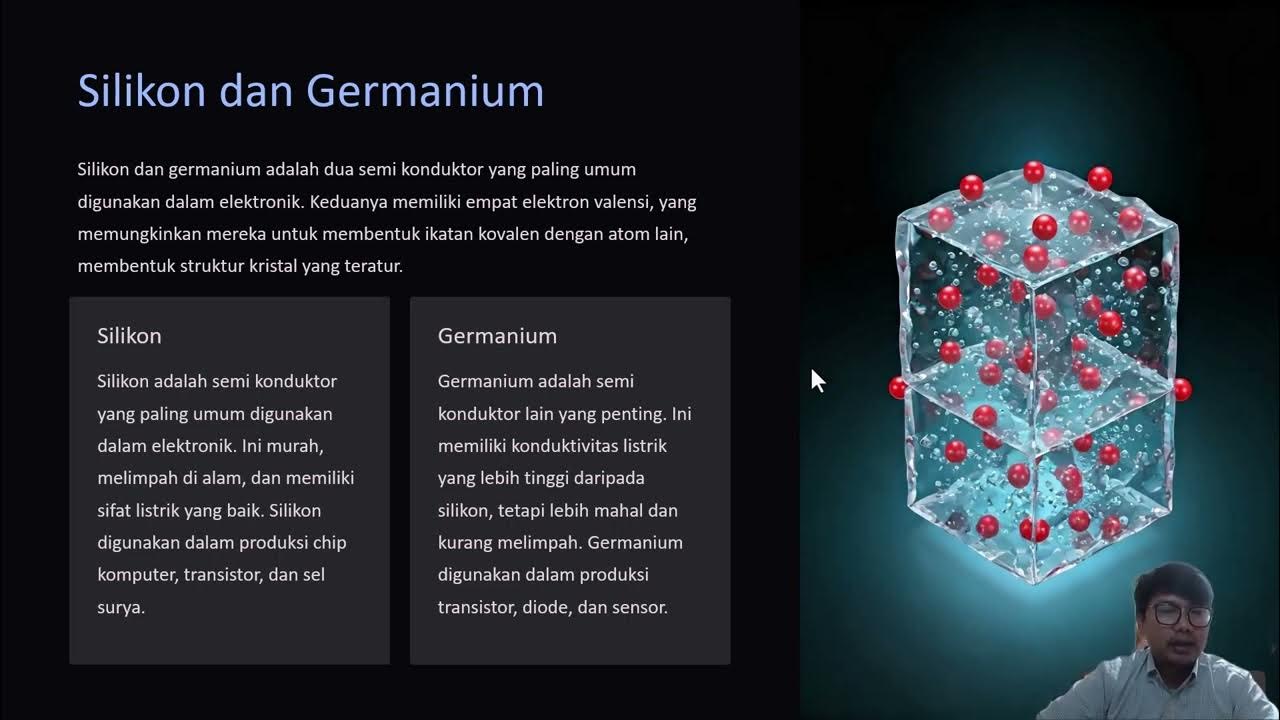003 INFORMASI: Pengetahuan Dasar Semikonduktor?
Summary
TLDRThis video explains the basic concepts of semiconductors, starting with conductors and insulators, and their atomic structures. It introduces copper as a good conductor due to its electron arrangement and neon as an insulator. The video then focuses on semiconductors, particularly silicon, and how their unique atomic structure makes them neither good conductors nor insulators. It delves into the process of doping, which enhances the conductivity of silicon by adding impurities, creating n-type and p-type semiconductors. The video concludes by discussing the creation of a PN junction, which is foundational for components like diodes.
Takeaways
- 🔌 Semiconductors are materials that are neither conductors nor insulators. To understand diodes, transistors, or integrated circuits (ICs), one must first learn about semiconductors.
- ⚡ Conductors, such as copper, have free electrons that can easily be displaced to create electric current, making them good conductors.
- 🛡️ Insulators, like neon, have tightly bound electrons that are difficult to displace, meaning they do not conduct electricity easily.
- 🧪 Semiconductors, like silicon, have four valence electrons and are neither good conductors nor insulators, placing them in between.
- 🔗 Silicon atoms form covalent bonds by sharing valence electrons with neighboring atoms, creating a stable crystal structure.
- 💡 The behavior of semiconductors is temperature-dependent. Heat causes silicon atoms to vibrate, freeing electrons and creating 'holes', allowing limited conductivity.
- 🧲 Doping is the process of adding impurities to a pure semiconductor, such as silicon, to increase its conductivity by introducing more free electrons or holes.
- ➕ N-type semiconductors are doped with elements like phosphorus to increase free electrons, making electrons the majority charge carriers.
- ➖ P-type semiconductors are doped with elements like boron to create more holes, making holes the majority charge carriers.
- ⚙️ The combination of P-type and N-type materials forms a PN junction, which is the foundation for creating devices like diodes.
Q & A
What is a semiconductor?
-A semiconductor is a material that has electrical conductivity between that of a conductor and an insulator. The most common semiconductor material is silicon, which has four valence electrons.
Why is copper a good conductor of electricity?
-Copper is a good conductor because it has one valence electron in its outermost shell, which can be easily displaced by a small amount of voltage, allowing for a free flow of electrons and thus electric current.
What is the difference between a conductor and an insulator?
-A conductor, like copper, allows free movement of electrons due to its weak attraction between its nucleus and outermost electrons. An insulator, like neon, has a strong attraction between its nucleus and outer electrons, preventing free electron movement and thus blocking electrical current.
What are valence electrons, and why are they important in electrical conduction?
-Valence electrons are the outermost electrons in an atom. They are important in electrical conduction because they can move easily when a voltage is applied, creating a flow of current. The number of valence electrons determines if a material is a conductor, insulator, or semiconductor.
How do semiconductors behave differently from conductors and insulators?
-Semiconductors, like silicon, have four valence electrons, which means they have intermediate electrical conductivity. They do not conduct electricity as well as conductors but are better than insulators. This property can be modified through doping to improve their conductivity.
What happens to the structure of silicon when it forms a crystal?
-In a silicon crystal, each silicon atom shares its four valence electrons with four neighboring silicon atoms, forming strong covalent bonds. This sharing of electrons allows the material to function as a semiconductor.
What is doping in semiconductors, and why is it important?
-Doping is the process of adding impurities, or dopants, to a pure semiconductor to change its electrical conductivity. Doping increases the number of free electrons or holes in the semiconductor, making it more conductive.
What is the difference between an n-type and a p-type semiconductor?
-An n-type semiconductor is doped with pentavalent atoms, which add extra electrons to the material, making electrons the majority carriers. A p-type semiconductor is doped with trivalent atoms, which create holes that act as positive charge carriers, making holes the majority carriers.
How does the formation of covalent bonds in silicon affect its conductivity?
-The covalent bonds formed between silicon atoms restrict the movement of electrons. However, when energy, such as heat or a voltage, is applied, some electrons can break free from their bonds, contributing to the material's conductivity.
What happens to a semiconductor when a voltage is applied across it?
-When a voltage is applied across a semiconductor, free electrons move toward the positive terminal, while holes move toward the negative terminal. This creates an electric current as electrons and holes flow in opposite directions within the semiconductor material.
Outlines

このセクションは有料ユーザー限定です。 アクセスするには、アップグレードをお願いします。
今すぐアップグレードMindmap

このセクションは有料ユーザー限定です。 アクセスするには、アップグレードをお願いします。
今すぐアップグレードKeywords

このセクションは有料ユーザー限定です。 アクセスするには、アップグレードをお願いします。
今すぐアップグレードHighlights

このセクションは有料ユーザー限定です。 アクセスするには、アップグレードをお願いします。
今すぐアップグレードTranscripts

このセクションは有料ユーザー限定です。 アクセスするには、アップグレードをお願いします。
今すぐアップグレード5.0 / 5 (0 votes)






